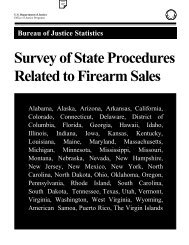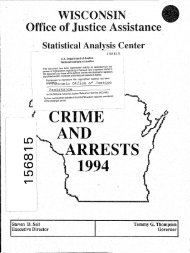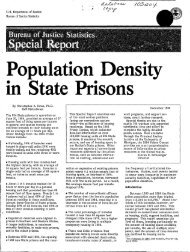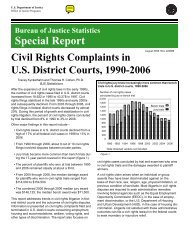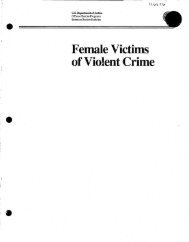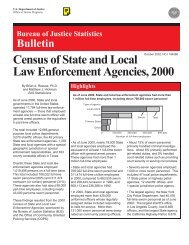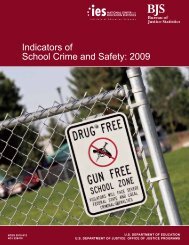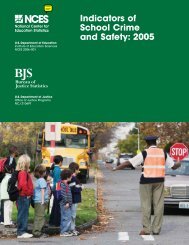Sourcebook of Criminal Justice Statistics, 1983 - Bureau of Justice ...
Sourcebook of Criminal Justice Statistics, 1983 - Bureau of Justice ...
Sourcebook of Criminal Justice Statistics, 1983 - Bureau of Justice ...
You also want an ePaper? Increase the reach of your titles
YUMPU automatically turns print PDFs into web optimized ePapers that Google loves.
- ---------~Expenditure and Employment Data for the <strong>Criminal</strong> <strong>Justice</strong> System-Survey methodology and definitions <strong>of</strong> termsNJTE: The following information was provided by the <strong>Bureau</strong> <strong>of</strong> <strong>Justice</strong> <strong>Statistics</strong> and the U.S.<strong>Bureau</strong> <strong>of</strong> the Census.Survey methodologyAs in previous editions <strong>of</strong> this annual publication, several tablesshow comparisons <strong>of</strong> criminal justice expenditure and full-timeequivalent employment with the total general expenditure and full-timeequivalent employment for all functions <strong>of</strong> the particular government orlevel c.f government. Prior to the fiscal year 1971 report, localgovernment total expenditure and full-time equivalent employmentincluded data for independent school districts and special districts aswell as for general local governments, i.e., counties, municipalities, andtownships. Beginning with the 1970-71 report, however,' the totalgeneral expenditure and total full-time equivalent employment figuresshown for the "local" level <strong>of</strong> government in these comparisons includedata for units <strong>of</strong> general local government only.The "variable pass-through" provisions <strong>of</strong> the Omibus CrimeControl Act <strong>of</strong> 1970 reqUired that the concept <strong>of</strong> "local" government beconfined to units <strong>of</strong> general local government in determining the ratio<strong>of</strong> State-to-Iocal government criminal justice expenditure. Beginningwith the fiscal year 1971 report, the same concept was appliedconsistently throughout the publication to reflect the intent <strong>of</strong> the low.Therefore, the total general expenditure and total full-time equivalentemployment figures used for comporison with criminal justice figures donot include indepmdent school districts or special districts. Thischange may result in significant differences from the percentages shownfor years prior to fiscal year 1971 in those States where education islargely the responsibility <strong>of</strong> independent school districts, or wherethere are large special districts. <strong>Criminal</strong> justice e)tpenditure andemployment data in this series have always been for units <strong>of</strong> generallocal government only. As in previous reports, however, Appendix I <strong>of</strong>the Source shows those independent school districts and specialdistricts having significant special police expenditures and employment.In addition, Appendix I <strong>of</strong> the Source includes seporate data for campuspolice <strong>of</strong> colleges and universities that are dependent agencies <strong>of</strong> Stateand local governments--data that are also included in the summaryfigures for State and local governments.Readers should be generally cautious in compllring governments,because other differences in functional responsibilities from State-toState and government-to-government can also affect the comparability<strong>of</strong> expenditure and employment data. For example, some Stategovernments directly administer certain activities that elsewhere areundertaken by local governments, with or without fiscal aid, and thesame variation in the division <strong>of</strong> responsibilities exists for counties andcities. Sampling error and response error are discussed in the followingsection.The documents used to collect data did not ,-:onsistently providefull itemization <strong>of</strong> expenditure or employmp.·nt for the sectorsubcotegories presented in this report. As a resull, sector breakdownsmay be incomplete for porticular governmental units.Because <strong>of</strong> rounding, the detail data in some tables may not oddprecisely to the totals shown.Survey coverageThe survey covered the Federal Government, (III Stategovernments, and a representutive sample <strong>of</strong> local governments withineach State. Data were collected for all county governments(regardless <strong>of</strong> size), for all municipolities (and townships in ~he NewEngland and Middle Atlantic States) having a 1977 populaTion <strong>of</strong> 10,000or more, and for a sample <strong>of</strong> the remaining municipalities and townshipswith less than 10,000 population, selected according to the relativesize <strong>of</strong> their annual expenditures as reported in the 1977 Cel'lSus <strong>of</strong>Governments. The survey panel included the Federal Government, the5U State governments, and 11,855 local governments (3,040 countygovernments, 6,728 municipalities, and 2,067 townships).The sa.'nple selected to develop local government figures Is one <strong>of</strong>all possible samples <strong>of</strong> the same size that could have been chosen usingthe same sampling design. Estimates derived from these differentsamples would differ from each other, and also from a complete censususing the same data collection procedures. This variation O!nong allpossible estimates is ~ompling error. Because all St"fe end countygovernments were included in the surVf~y, State and r- ;\''f1ty figures arenot subject to sampling error.The local government sample was delligned to produce anestimate for each State <strong>of</strong> the portion <strong>of</strong> total criminal justiceexpenditures made by local governments with a relative sampling error{)f less than one-half <strong>of</strong> I percent.The data are also subject to the inaccuracies In classification,response, and processing that would occur if a complete census hadbeen conducted under the same conditions as the sample survey. Everyeffort was made to keep such errors to a minim'Jm through core Inexamining, editing, and tabulating the data submitted by government<strong>of</strong>ficials. Follow-up procedures were used ~xter.sively to clarifyInadequate and inconsistent survey returns.Survey periodFederal Government data are shown for fiscal yeor 1979, whichbegan on Oct. I, 1978 and ended Sept. 30, 1979.The State expenditure data presented in this report cover thefiscal year ending June 30, 1979 for all Sfates except four who~e fiscalyears ended as follows: New York, Mar. 31, 1979; Texas, Aug. 31, 1979;and Alabama and Michigan, Sept. 30, 1979. However, there are someState agencies that operate on a different fiscal year basis from therest <strong>of</strong> the State government. In such instances, figures shown are forthe agency's fiscal year that ended within the State's regular fiscalyear.For local governments, the 1979 fiscal years reported are thoseclosed between July I, 1978 and June 30, 1979. Most municipalitiesand counties ended their fiscal years on Dec. 3 I, 1978 or June 30,1979. The fiscal year reported for Washington, D.C. ended on Sept. 30,1979.Employment data shown for ,Federal, State, and local governmentsare for October 1979.Data collectionThe survey was accomplished using two methods <strong>of</strong> datacollection: field compilation and mai I canvass. Trained fieldrepresentatives compiled expenditure and employment data from thegovernments' own records for the 50 States, 350 largest counties, 415largest cities, and selected smaller units. The compilation work wasdone between October 1979 and June 1980. All other units in thesample were canvassed by moil for expenditure and employment dataover a 5-month period beginning in January 1980 and ending in May1980. Response for field-compiled units was 100 percent. Theresponse from moil canvass units was 91 percent.The field survey efforts and mail canvass were supplemented byreference to a variety <strong>of</strong> published gO\'"Hnment docum2nts such asi:x.,dgets, financial statements, and audit reports. In some cases, suchsources are the basis for breakdowns <strong>of</strong> totals into more detailedemployment and expenditure figures.The expenditure and employment data for the Fede' II Governmentwere collected through a special mail survey, with teleph,)ne followup,<strong>of</strong> Federal criminal justice agencies. For report:; previa IS to fiscal year1971, expenditure data were derived from the Budge! <strong>of</strong> the UnitedStates Government and employment figures were obtained from theU.S. Civil Service Comnission.Definitions <strong>of</strong> termsThe definitions are those applied in the field compilation <strong>of</strong> datafor the 50 States, 350 largest counties, and 415 largest cities. Thesedefinitions were necessarily summarized for inclusion in the surveyquestionnaires (see Appendix 3 <strong>of</strong> Source) sent to governments on themall portion <strong>of</strong> the survey.Government expenditure--"Expenditure" comprises all amounts<strong>of</strong> money poid out (net <strong>of</strong> any correcting transactions) other than forretirement <strong>of</strong> debt (including interest), investment In securities,extensions <strong>of</strong> loons, or agency transactions. It includes only externalcash poyments and excludes any Intragovernmentol transfers and noncosh transactions, such as the provision <strong>of</strong> meals or housing <strong>of</strong>employees. It also includes any poyments financed from borrowing,fund balances, intergovernmental revenue, and other current revenue.In several Instances, two or more governments shore the expense <strong>of</strong>maintaining a court or other criminal justice agency. In these cases,the allocable direct expenditure amount is repor1 ed for eachgovernment in the appropriate category. When a goverrvnent payspensions directly to retired employees from appropriated funds, suchpayments are included as expenditure <strong>of</strong> the government concerned.However, State and local government contributions to retirementsystems and various other employee benefits are not Included Inexpenditure data, since the majority <strong>of</strong> governments make lump-fumcontributions to plans covering all government employees and cannotreport for criminal justice employees separately. Neither Ingovernments' basic accounting records (from which criminal justiceexpenditure figures are drown) nor in the records <strong>of</strong> their general.·coverage employee benefit systems is there usually any breakdown <strong>of</strong>QT)Ounts contributed In terms <strong>of</strong> the various agencies or functionsInvolved. Nor hos on adequate procedure for calculating the proportion<strong>of</strong> such contributions allocable to criminal justice employees,4\Preceding page blank637




